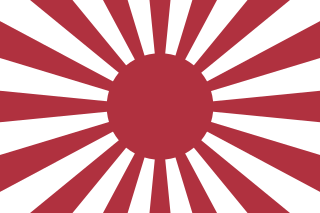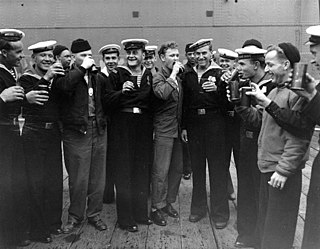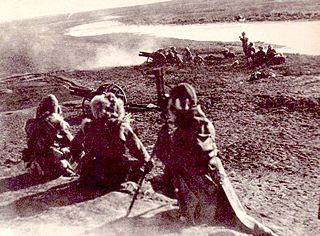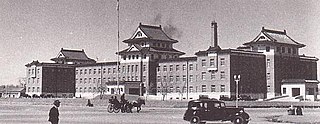Related Research Articles

The Imperial Japanese Army (IJA) was the principal ground force of the Empire of Japan. Forming one of the military branches of the Imperial Japanese Armed Forces (IJAF), it was controlled by the Imperial Japanese Army General Staff Office and the Army Ministry, both of which were nominally subordinate to the Emperor of Japan, the supreme commander of IJAF. During the 20th century, an Inspectorate General of Aviation became the third agency with oversight of the IJA. At its height, the IJA was one of the most influential factions in the politics of Japan and was one of the most powerful armies in the world. The IJA was notorious for committing numerous war crimes before and during World War II, including the Second Sino-Japanese War, the Pacific War, the Nanjing Massacre and the Bataan Death March.

The Invasion of the Kuril Islands was the World War II Soviet military operation to capture the Kuril Islands from Japan in 1945. The invasion, part of the Soviet–Japanese War, was decided on when plans to land on Hokkaido were abandoned. The successful military operations of the Red Army at Mutanchiang and during the invasion of South Sakhalin created the necessary prerequisites for invasion of the Kuril Islands.
The Karafuto Fortress was the defensive unit formed by the Karafuto fortification installations, and the Karafuto detachment of Japanese forces, the 88th Division. The headquarters was in Toyohara, capital of the province, based on the Suzuya plain, in the Southern Karafuto area, not far from the ports of Otomari and Maoka.

The Soviet–Japanese War, known in Mongolia as the Liberation War of 1945, was a campaign of the Second World War that began with the Soviet invasion of Japanese-occupied territory following the Soviet declaration of war against Japan on 7 August 1945. The Soviet Union and Mongolian People's Republic toppled the Japanese puppet states of Manchukuo in Manchuria and Mengjiang in Inner Mongolia, as well as northern Korea, Karafuto on the island of Sakhalin, and the Kuril Islands. The defeat of Japan's Kwantung Army helped bring about the Japanese surrender and the end of World War II. The Soviet entry into the war was a significant factor in the Japanese government's decision to surrender unconditionally, as it was made apparent that the Soviet Union was not willing to act as a third party in negotiating an end to hostilities on conditional terms.

Kōji Sakai was a lieutenant general in the Imperial Japanese Army during the Second Sino-Japanese War

The Manchukuo Imperial Army was the ground force of the military of the Manchukuo, a puppet state established by Imperial Japan in Manchuria, a region of northeastern China. The force was primarily used for fighting against Communist and Nationalist guerrillas in Manchukuo but also took part in battle against the Soviet Red Army on several occasions. It initially consisted of former National Revolutionary Army troops of the "Young Marshal" Zhang Xueliang who were recruited after the Japanese invasion of Manchuria en masse, but eventually expanded to include new volunteers and conscripts. The Imperial Army increased in size from about 111,000 troops in 1933 to an estimated strength of between 170,000 and 220,000 soldiers at its peak in 1945, being composed of Han Chinese, Manchus, Mongols, Koreans, Japanese, and White Russians. Throughout its existence the majority of its troops were considered to be mostly unreliable by their Japanese officers and advisers, due to poor training and low morale.

The Empire of Japan's Kwantung Army invaded Manchuria on 18 September 1931, immediately following the Mukden Incident. At the war's end in February 1932, the Japanese established the puppet state of Manchukuo. Their occupation lasted until the success of the Soviet Union and Mongolia with the Manchurian Strategic Offensive Operation in mid-August 1945, towards the end of the Second World War.
The Guards Mixed Brigade was a military unit of the Imperial Japanese Army.
The 2nd Guards Mixed Brigade was a military unit of the Imperial Japanese Army.

The Jinzhou Operation or Chinchow Operation was an operation in 1931 during the Japanese invasion of Manchuria, which was a preliminary, contributing factor to the outbreak of the Second Sino-Japanese War in 1937.

Between 1937 and 1945 the Japanese Imperial Army formed 126 Independent Mixed Brigades, typically composed of various units detached from other formations. Some were composed of separate, independent assets. These brigades were task organized under unified command and were normally used in support roles, as security, force protection, POW and internment camp guards and labor in occupied territories. An Independent Mixed Brigade had between 5,000 and 11,000 troops.

The 2nd Division was an infantry division in the Imperial Japanese Army. Its tsūshōgō was Courageous Division.
7th Division was an infantry division in the Imperial Japanese Army. Its call-sign was the Bear Division.

The 19th Division was an infantry division in the Imperial Japanese Army. Its tsūshōgō code name was the Tiger Division. It was also occasionally referred to in Korean accounts as Ranam Division, after the location of its main base. The 19th Division and the 20th Division were both raised as a garrison force for Korea. After Japan's victory in the Russo-Japanese War of 1904-1905, and subsequent occupation, and then annexation of Korea in 1910, the need was felt for a dedicated garrison force, raised from people with local knowledge. The 19th Division was stationed in far northeast Korea, in what is now North Hamgyong Province. The division received its colors on 24 December 1915 and headquarters have moved to Yongsan District 16 April 1916; however, the division was not considered combat-ready until 1918. The delay was due to limited funding available for the division to build its facilities in Korea and the need to recruit and train personnel from mainland Japan. In addition, the new division was beset with problems related to malaria and shigellosis at its main base at Ranam in northern Korea, having recorded 672 disease-related officers casualties during 1917. As result, the headquarters have moved to Ranam-guyok only 10 April 1919. The first commander of the 19th Division was Lieutenant General Tachibana Koichirō.
The 4th Mixed Brigade was a military unit of the Imperial Japanese Army.
This article details the organization of the Imperial Japanese Army.

The Kwantung Army was a general army of the Imperial Japanese Army from 1919 to 1945.

The Soviet invasion of South Sakhalin, also known as the Battle of Sakhalin, was the Soviet invasion of the Japanese portion of Sakhalin Island known as Karafuto Prefecture. The invasion was part of the Soviet–Japanese War, a minor campaign in the Asian Theatre during Second World War.
The 88th Division was an infantry division in the Imperial Japanese Army. Its call sign was the Essential Division. It was created 28 February 1945 in Toyohara It was a triangular division. The divisional backbone was the Karafuto mixed brigade.
The 132nd independent mixed brigade was an infantry brigade of the Imperial Japanese Army. It was formed 10 July 1945 in Dongning, Heilongjiang for border guard duties.
References
- ↑ Madej, W. Victor. Japanese Armed Forces Order of Battle, 1937–1945 [2 vols] Allentown, PA: 1981
- ↑ Japanese Forces Hokkaido, Karafuto and Kurile Islands May 1945